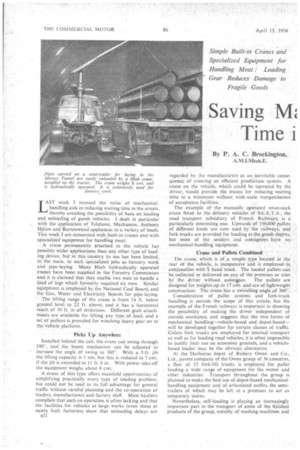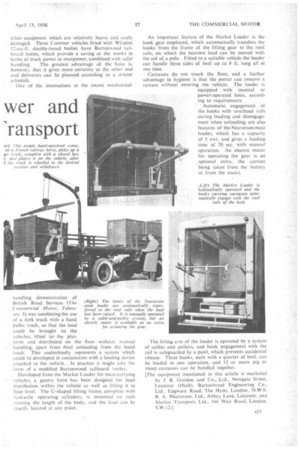Saving M wer and Time i 'ransport
Page 56

Page 57

If you've noticed an error in this article please click here to report it so we can fix it.
AST week I stressed the value of mechanical
handling aids in reducing waiting time in the streets, thereby avoiding the possibility of bans on loading and unloading of goods vehicles. I dealt in particular with the application of Telehoist, Mackaness, Anthony Hoists and Burtonwood appliances to a variety of loads. This week Jam concerned with built-in cranes and with specialized equipment for handling meat.
Acrane permanently attached to the vehicle has possibly wider applications than any other type of loading'device, but in this -country its use has been limited, in the main, to such specialized jobs as forestry work and pipe-laying. Many •Hiab hydraulically operated cranes 'have been supplied to the Forestry Commission and -it is clairned•that they enable two men to handle' a road of logs which' formerly required six men. Similar equipment is employed by the National Coal Board, and the Gas, Water and Electricity Boards for pipe-laying. ' The liftingrange . of the crane is from 14 ft. below ground level to 22 ft. above, and it has a horizontal reach of 30 ft. in all directions. Different grab attachments are available for lifting any type of load, and a set of pulleys is providedfor -winching heavy gear on to the-Vehicle platform.
" Picks Up Anywhere
Installed behind the cab, the crane can swing through 190°, and the boom mechanism can be adjusted to increase the angle of swing to 360°. With a 5-ft. jib the lifting capacity is 1 ton, but this is reduced to 7 cwt. if the jib is extended to 11 ft. 6 in. With power take-off the equipment weighs about 8 cwt.
A crane of this type offers manifold opportunities of simplifying practically every type of loading problem, but could not be used to its full advantage for general traffic without careful planning and the co-operation of traders, manufacturers and factory staff. Most hauliers complain that such co-operation is often lacking and that the facilities for vehicles at large works (even those at newly built factories) show that unloading delays are 822 regarded by the manufacturers as an inevitable consequence Of creating an efficient production system. A crane on the vehicle, which could be operated by the driver, would provide the means for reducing waiting time to a minimum without wide-scale reorganization of acceptance facilities.
The example of the manually operated swan-neck crane fitted to the delivery vehicles of S.C.E.T.A., the road transport subsidiary of French Railways; is a particularly interesting one. Upwards of 150,000 pallets of different kinds are now used by the railways, and • fork trucks are provided for loading at the goods depots, but most of the senders and consignees have no mechanical-handling equipment.
Crane and Pallet§ Combined
The crane, which is of a simple type located at the rear of the vehicle, is inexpensive and is employed in conjunction -with % hand truck. The loaded pallets can. be collected or deliyered on any of the premises or sites by the driver without asSiStee. The pallets are designed for weights up to IT cwt. and 'are of lightweight construction. The crane has a swivelling angleJaf Consideration of pallet systems and fork-truck handling is outside the scope of this article, but the example of the French railways is important in showing the possibility of making the driver independent of outside assistance, and suggests that the two forms of mechanical handling—vehicle-based and depot-basedwill be developed together for certain classes of traffic. Unless fork trucks are employed for internal transport as well as for loading road vehicles, it is often impossible to justify their use on economic grounds, and a vehiclebased loader may be the obvious alternative.
At the Darlaston depot of Rubery Owen and Co., Ltd., parent company of the Owen group of 36 concerns, a fleet of 15 fork-lift trucks is employed for pallet loading a wide range of equipment for the motor and other industries: Transport throughout the group is, planned to make the best use of depot-based mechanicalhandling equipment and of articulated outfits, the semitrailers of which may be left at a premises to act as temporary stores.
Nevertheless, self-loading is playing an increasingly important part in the transport of some of the finished products of the group, notably of washing machines and other equipment which are relatively heavy and easily damaged. Three Commer vehicles fitted with Wilsdon 12-cu.-ft. double-tiered bodies have Burtonwood tailboard hoists, which provide a saving at the works in terms of truck power or manpower, combined with safer handling. The greatest advantage of the hoist is, however, that it gives more certainty at the other end and deliveries can be planned according to a stricter schedule, One of the innovations at the recent mechanical
handling demonstration of British Road Services (The Commercial Motor, February 3), was combining the use of a fork truck with a hand pallet truck, so that the load could be brought to the vehicles; lifted to the platform and distributed on the floor without manual handling, apart from final unloading from the hand truck. This• undoubtedly represents a system which could be developed in conjunction with a loading device attached to the vehicle. In practice it might take the form of a modified Burtonwood tailboard trolley.
Developed from the Market Loader for meat-carrying vehicles, a gantry hoist has been designed for load distribution within the vehicle as well as lifting it to floor level. The U-shaped lifting frame, complete with hydraulic operating cylinders, is mounted on rails running the length of the body, and the load can be exactly located at any point.
(Right) The hooks of the Neaverson . meat loader are automatically transferred to the roof rails when the load has been raised. It is manually operated hy a cable-and-pulley system, but an electric motor is available as an extra for actuating 'the gear.
An important feature of the Market Loader is the hook gear employed, which automatically transfers the hooks from the frame of the lifting gear to the roof rails, on which the heaviest load can be moved with the aid of a pole. Fitted to a suitable vehicle the loader can handle three sides of beef up to 9 ft. long all at one time.
Carcasses do not touch the floor, and a further advantage in hygiene is that the porter can remove a carcass without entering the vehicle. The loader is equipped with manual or power-operated hoist,' according to requirements.
Automatic engagement of the hooks with overhead rails during loading and disengagement when unloading, are also features of the Neaverson meat loader, which has a capacity of 5 cwt. and gives a loading time of 20 sec. with manual operation. An electric motor for operating the gear is an optional extra, the current being taken from the battery or from the mains.
The lifting arm of the loader is operated by a system of cables and pulleys, and hook engagement with the rail is safeguarded by aPawl, which prevents accidental release. Three hooks, each with a quarter of beef, can be loaded in one operation, and 12 or more pig or sheep carcasses can be handled together.
[The equipment mentioned in this article is marketed by J. R. Gordon and Co., Ltd., Newgate Street, Leicester (Iiiah); Burtonwood Engineering Co., Ltd., Edgware Road, The Hyde, London, N.W.9: R. A. Neavcrson, Ltd., Abbey Lane, Leicester, and Market Transport, Ltd., 166 Weir Road, London. S.W.12.]




















































































































